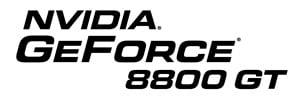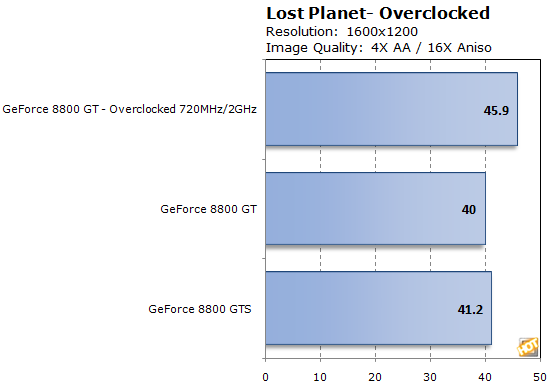NVIDIA GeForce 8800 GT - G92 Takes Flight
Overclocking, Power Consumption and Heat

With any new GPU architecture, especially one built on a new, leading-edge 65nm manufacturing process, we'll always try to push the envelope a bit in an effort to see just how much headroom the card has above and beyond factory specifications.
|
Ultimately we managed to crank up our GeForce 8800 GT reference card to a blistering 720MHz core speed and a full 2GHz memory interface speed. The net result is a 20% core speed increase and an 11% memory interface speed increase. Here are the results.


In both our Lost Planet and ET: Quake Wars tests we realized a 14 - 15% frame rate increase, which loosely correlates to our collective core and memory speed boosts that we achieved while overclocking the product. Overall we are impressed with the available margin in the GeForce 8800 GT, especially when you consider its rather modest thermal management solution. More on this next.
|
Below we've graphed total power consumption for the systems we used for testing, along with their associated graphics subsystems. Our goal was to give you all an idea as to how much power each configuration used. Please keep in mind that we were testing total system power consumption at the outlet here, not just the power being drawn by the video cards alone.

The first notable you should observe here is that obviously the nForce 680i-based systems draw significantly more power than the Intel 975X-based system. This is mostly due to the larger number of PCI Express lanes available in the 680i chipset. Beyond that, the area to focus on is the variance in power consumption from idle to load conditions, which shows worst-case power consumption with the GPUs under full load. We simply looped 3DMark 06's shader model 3 test and recorded power consumption with a power analyzer drawing from the wall outlet. The GeForce 8800 GT drew an extra 73 watts under under a graphics workload while in stark contrast, the Radeon HD 2900 XT drew 168 watts more under the same load condition. One word describes the performance-per-watt variance here; ouch.
Acoustics and Heat:
As we noted earlier, the GeForce 8800 GT's heatsink and fan solution is certainly svelt, with its single slot design but unfortunately that comes at the cost of heat and noise. In fact, the 8800 GT is probably the noisiest product to come out of NVIDIA in a long time. The card will likely only annoy users that are looking for exceptionally quiet computing solutions but for the average usage model, these new cards will be tolerable. We're hopeful however, that some third-party board partners will come up with more innovative, quiet cooling solutions.
In terms of its thermal profile, the GeForce 8800 GT runs relatively hot. We measured 155ºF on the exterior of the heatsink face plate and 145ºF on the backside of the board directly under the GPU, with a digital infrared thermometer.






